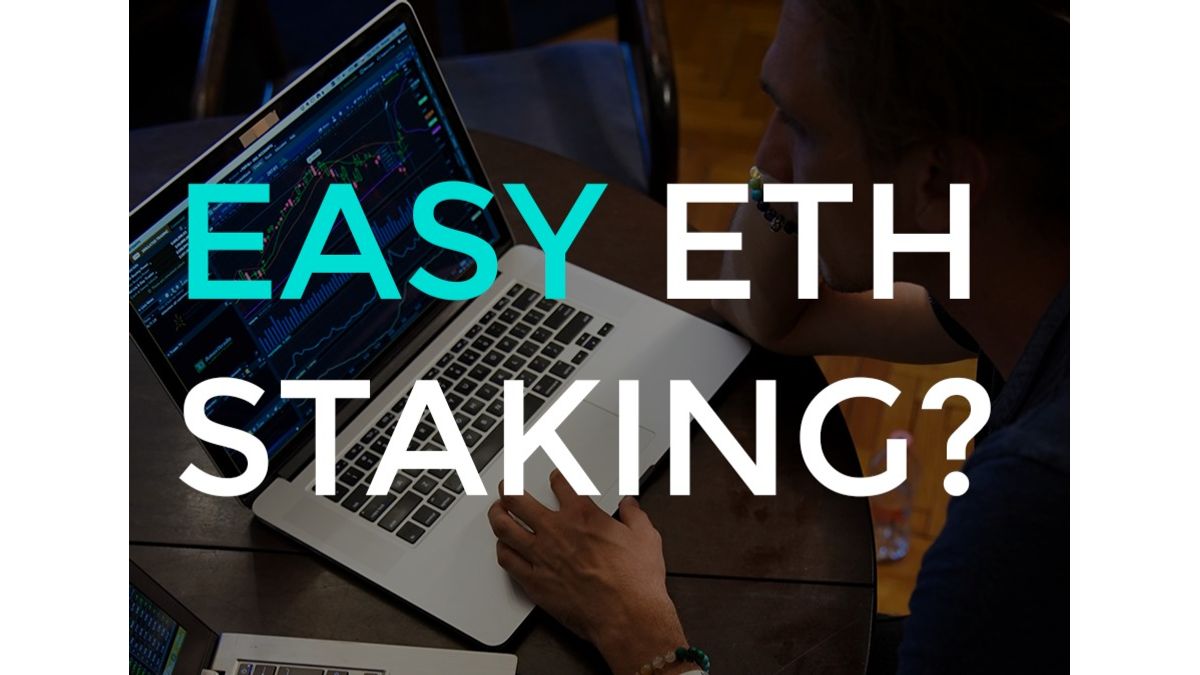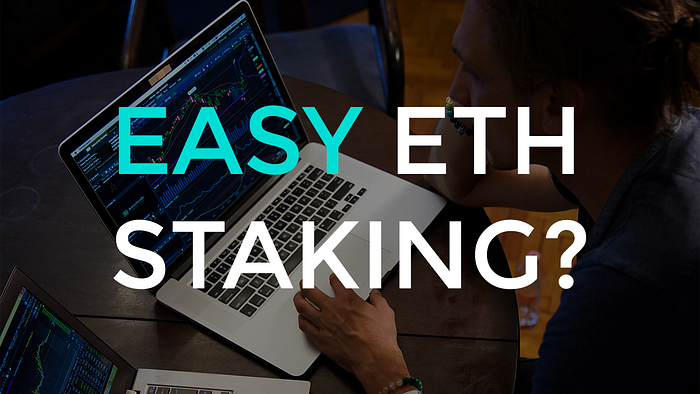
January 30, 2023
Avado Makes ETH2.0 Staking Easy
With Ethereum finally being upgraded to Ethereum 2.0 after years of anticipation, it is an incredibly exciting time to be part of the Web3 landscape. With this excitement, there is also an incredibly lucrative opportunity for both new and experienced crypto proponents to start earning passive income by taking part in this exciting movement.

There are several solutions that allow you to stake Eth 2.0, and this article will explore those options and present you with the easiest and most effective way to start staking effortlessly.
How to stake Eth 2.0
When it comes to staking Eth 2.0, there are various options available to you. Each option, of course, has its own pros and cons and a varying level of difficulty.
Using an exchange
One of the more popular ways to stake is through a cryptocurrency exchange. The popularity of this method lies in its ease and accessibility, as newcomers to the space find that it takes very little technical know-how in order to start staking Eth 2.0 through this method.
For someone who is just getting started and searches the internet for a way to start earning money through staking, there is a very high likelihood that they will end up using a cryptocurrency exchange to do so. This is because exchanges offer a user-friendly experience that is accessible to almost everyone. In addition, they often provide a level of customer support that is typically not provided through other staking methods.
However, staking through a cryptocurrency exchange has significant drawbacks. These drawbacks relate to the fact that the Web3 movement is inherently designed to empower individuals, and relying on a centralized platform means leaving your finances in the hands of a third party that may not always have your best interest in mind. When you stake on an exchange, the exchange itself is in control of your digital assets, which can put your finances at risk .
In addition, staking through an exchange results in significantly diminished earnings. This is because the exchange will likely claim a portion of your staking rewards as a service fee. Many of these exchanges even take as much as 25% of your rewards. If you were to stake independently, on the other hand, you would receive these earnings in full.
Using a staking pool
Another method for staking Eth 2.0 is to make use of a staking pool. Here, users pool their resources together in order to stake and then divvy up the rewards. Typically, these pools will distribute the earnings proportionally depending on each user’s contribution.
Staking pools can be a great way to stake a currency in cases where you do not meet the minimum staking amount. With Eth 2.0, for instance, you need a minimum of 32 ETH (currently valued at over $49,900) to run a validator and stake independently. As this is certainly not a small sum of money, many people choose to make use of staking pools.
When it comes to this method, however, it is important to note that not all pools are created equally and that they can disproportionately limit your earnings. In addition, finding the right staking pool and getting started can be difficult, especially if you do not have the right equipment. This can be incredibly consequential for your earnings, as the different ways in which staking pools are managed will impact how much stakers within the pool actually earn. For instance, if a pool is managed in a way that results in downtime or fraudulent transactions being validated, it can be penalized by the network. As a result, the resources and effort you put into staking would be largely wasted.
Staking on your own
One way to stake Eth 2.0 is to do so completely independently. Per the project’s own online resource , staking on your own is a lucrative pursuit but can be difficult. In their words: “As much as we wish that solo staking was accessible and risk free to everyone, this is not reality. There are some practical and serious considerations to keep in mind before choosing to solo stake your ETH.”
Ethereum.org lists these considerations as having a familiarity with computers, pursuing relevant readings, understanding secure key management, knowing how to maintain your device, and having access to reliable uptime.
Staking on your own means having an incredible amount of freedom and getting to keep your own earnings, but meeting these prerequisites is a tall ask. In fact, even experienced traders or tech proponents can find this process challenging. In a broad sense, you will need to get hardware that you can use to stake, sync an execution layer client, sync a consensus layer client, generate your keys and load them into your validator client, and then monitor and maintain your node. For a more in-depth guide to pursuing this method, check out the official Eth 2.0 documentation .
In addition, trying to stake on your own can also impact your earnings if you do not have access to the right support or equipment. For example, stakers who are not able to maintain a high uptime will earn significantly less. In some drastic cases, inexperienced traders might even attempt to confirm fraudulent blocks. In these instances, you can be slashed by the Ethereum network and lose a portion of your stake. Finally, staking completely on your own without a dedicated staking device would mean having to spend your own time and resources trying to constantly maintain your device and keep up with network upgrades.
Staking Eth 2.0 without any drawbacks
While each of the methods above has significant drawbacks, there is actually a way to access all of the benefits of each staking method without having to rely on third parties, cut into your own earnings, or follow an arduous and complicated process.
With AVADO’s range of plug-and-play devices, we are allowing people all over the world to easily start staking. The best thing about using an AVADO device is that you are completely in control of the projects you stake and your own earnings — unlike when you rely on an exchange. At the same time, the plug-and-play design of the devices in our range means that anyone, even a complete beginner, can become an independent staker through just a few clicks.
In addition, for anyone who does not have enough ETH to meet the 32 ETH minimum staking amount, our software provides access to staking pools such as Rocket Pool . Thanks to our future-proof designs and powerful hardware, you will have reliable uptime and can earn more passive income while using these pools as a result.
AVADO’s range of devices are essentially pre-configured blockchain computers which enable you to simply plug them in, effortlessly sync the execution and consensus layer clients, and start staking Eth 2.0 right away. Since our devices actively support client diversity , you also have complete freedom over how you stake Eth 2.0 and any of the other projects we support.
How to start staking on your AVADO device
Staking Ethereum 2.0 on your AVADO device is incredibly easy and requires no prior programming or Web3 knowledge. If you would like to see a visual representation of how easy it is, check out this video on our YouTube channel . Otherwise, simply follow these steps:
- Navigate to the official Ethereum Staking Launchpad and confirm the prompts in the “Advisories” section. The Launchpad will ask you to select an execution client in order to set up a node. As AVADO supports client diversity, this choice is completely up to you.
- Fill in the remaining prompts on the Launchpad. It will then ask you to run a command line utility in order to generate your keys. This is typically a very technical process. Fortunately, using your AVADO device allows you to do it with ease.
- All you have to do is simply navigate to the user-friendly AVADO Dappstore that is ready to go right out of the box, and select the ETH2.0 Key Generator to install it. As the connection between you and your device is completely private, you can rest easy knowing that all of the control is in your hands.
- Click the “Configure Package” button once it’s finished installing. This will launch the automated wizard that allows you to generate and download your keys for staking. Once that’s done and you have set a password, press the “Generate Keys” button. Next, download the generated keys and then wipe them from the package.
- Navigate back to the Launchpad and continue until you reach the “Upload Deposit Data” step. Here, simply upload the file that you generated with your AVADO device. Then, select a wallet of your choice out of the options provided on the Launchpad.
- Back on your AVADO device, find the Ethereum Node from the Dappstore and press install. Next, make sure to also install your ETH2.0 validator package. These will take some time to sync to the Ethereum network, but in the meantime you can import your validator files. Simply open the validator that you are installing and upload the file that contains your validator key. Fill in the password that you set back in step 4.
- Pick another password for your wallet and make sure to store this password offline somewhere safe.
- On your AVADO Dashboard, you will be able to monitor the progress of your packages syncing to the network. Once they are ready, you can use this dashboard to easily view the status of your validator. Just like that, you are done and are actively staking Eth 2.0 — no prior crypto or programming knowledge is required!
With AVADO, it is really that easy to reap all of the benefits of staking with none of the drawbacks. No matter what your goals are in the space, we feel confident that a product in our range is right for you. To find out more about how you can effortlessly stake Eth 2.0 while earning passive income and remaining independent, visit our website today.